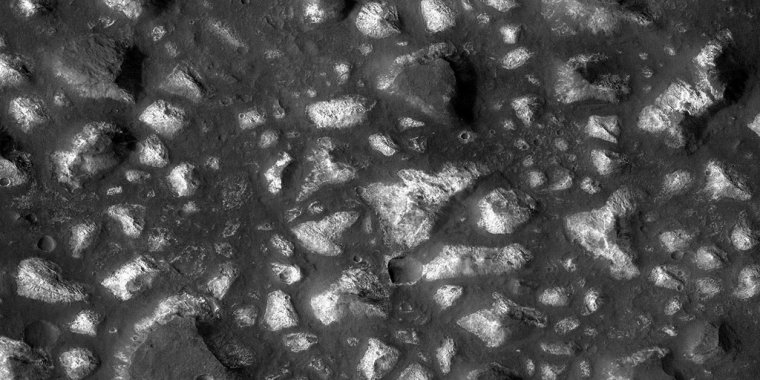| News / Space News |
Mars Study Yields Clues to Possible Cradle of Life
The discovery of evidence for ancient sea-floor hydrothermal deposits on Mars identifies an area on the planet that may offer clues about the origin of life on Earth.

This view of a portion of the Eridania region of Mars shows blocks of deep-basin deposits that have been surrounded and partially buried by younger volcanic deposits. ![]()
A recent international report examines observations by NASA's Mars Reconnaissance Orbiter (MRO) of massive deposits in a basin on southern Mars. The authors interpret the data as evidence that these deposits were formed by heated water from a volcanically active part of the planet's crust entering the bottom of a large sea long ago.
Mars today has neither standing water nor volcanic activity. Researchers estimate an age of about 3.7 billion years for the Martian deposits attributed to seafloor hydrothermal activity. Undersea hydrothermal conditions on Earth at about that same time are a strong candidate for where and when life on Earth began.
Earth still has such conditions, where many forms of life thrive on chemical energy extracted from rocks, without sunlight. But due to Earth's active crust, our planet holds little direct geological evidence preserved from the time when life began.
The possibility of undersea hydrothermal activity inside icy moons such as Europa at Jupiter and Enceladus at Saturn feeds interest in them as destinations in the quest to find extraterrestrial life.
Observations by MRO's Compact Reconnaissance Spectrometer for Mars (CRISM) provided the data for identifying minerals in massive deposits within Mars' Eridania basin, which lies in a region with some of the Red Planet's most ancient exposed crust.
The researchers estimate the ancient Eridania sea held about 50,000 cubic miles (210,000 cubic kilometers) of water. That is as much as all other lakes and seas on ancient Mars combined.
The mix of minerals identified from the spectrometer data, including serpentine, talc and carbonate, and the shape and texture of the thick bedrock layers, led to identifying possible seafloor hydrothermal deposits. The area has lava flows that post-date the disappearance of the sea.
The researchers cite these as evidence that this is an area of Mars' crust with a volcanic susceptibility that also could have produced effects earlier, when the sea was present. (NASA)
YOU MAY ALSO LIKE

